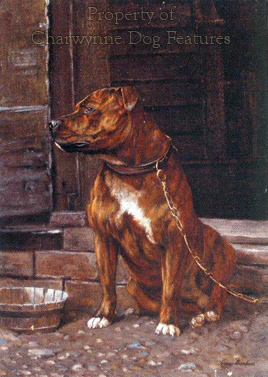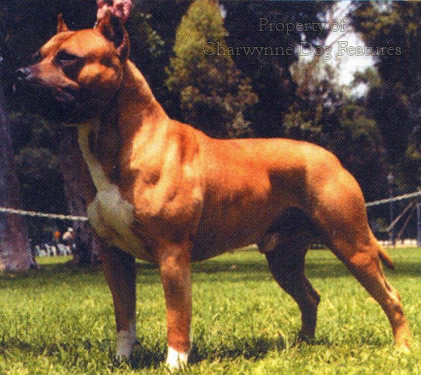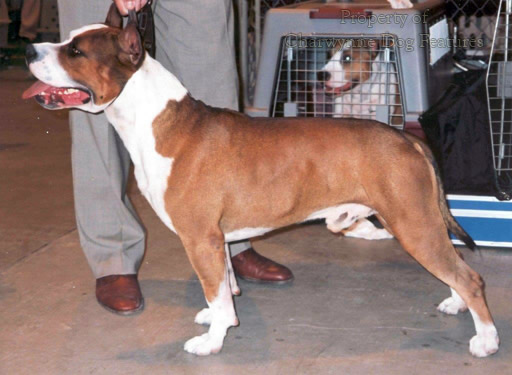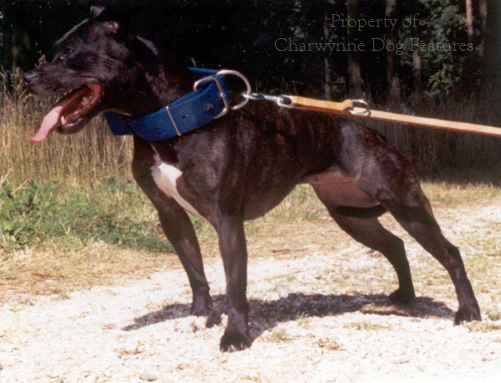455 Breeding Bull in Terriers
BULLYING THE TERRIER
by David Hancock

 These are still difficult days for those who favour the distinctive breeds of terrier with Bulldog blood. The threat of action under the now discredited Dangerous Dogs Act remains a constant worry. That apart, the untypical anatomies inflicted on Bull Terriers, with their relatively new 'downface' or ruggerball head, and Staffordshire Bull Terriers, with their short whippety legs, is most surprising in two breeds whose fanciers were once archetypal traditionalists, level-headed and single-minded.
These are still difficult days for those who favour the distinctive breeds of terrier with Bulldog blood. The threat of action under the now discredited Dangerous Dogs Act remains a constant worry. That apart, the untypical anatomies inflicted on Bull Terriers, with their relatively new 'downface' or ruggerball head, and Staffordshire Bull Terriers, with their short whippety legs, is most surprising in two breeds whose fanciers were once archetypal traditionalists, level-headed and single-minded.
If you look at paintings of these two admirable breeds in the last century, the loss of true type is soon apparent. This may apply to other breeds too of course, but when it concerns these two particular breeds, it seems especially sad. I always think of those in these breeds as being resistant to the usual pressures: the pursuit of fad breed points in each decade, some temporary flight of fancy or one influential breeder's partialities. You only have to look at the faces of some of the characters in old paintings of these breeds to see why I say that.
No rational humane person wants to own a dog for use in dog-fighting, a cowardly distasteful activity mainly designed to release undesirable aggression in unpleasant humans. But I can see distinct merit and no harm in desiring to reproduce in a breed of dog the physique which permits it to carry out its original function. In such a way can you obtain sounder setters and scenthounds, hounds and herding dogs. In 'Stonehenge's 'Dogs of the British Islands' of 1878, he states that "the bull terrier is still judged by the fighting standard -- that is to say, he must have all the points, mental as well as bodily, which are necessary to the fighting dog". In 'Staffordshire Bull Terriers', edited by Major Count V.C.Hollender, of 1952, H.N.Beilby writes: "...we can, if we wish, produce dogs which in virtue of their build, toughness, courage and intelligence are most likely to inherit and perpetuate the sterling qualities of their ancestors. Are we doing this? Only, I fear to a limited extent!" Sadly, his words apply as much today as they did nearly half a century ago. Fighting dogs were superbly fit, hard-muscled, fiercely-determined (to the point of self-destruction) but eminently sound anatomically.

Nowadays, thankfully, we do not seek unacceptable, sustained ferocity in our dogs, but soft-muscled, unfit, overweight dogs of this type stand out perhaps more than most others. A podgy Bull Terrier looks quite dreadful; an overweight Staffie can look almost porcine. I have seen both at Crufts, and it saddens me, for these are justly famous British breeds on their way to being ruined. For former canine gladiators to be fat or otherwise unfit, have poor movement and lack fitness is distressing. Good movement comes mainly from a combination of sound construction and physical condition. Movement is an excellent commentary on the whole dog and unfailingly reveals anatomical faults. For a judge to reward dogs which were not good on the move is depressing; poor movement is a serious fault and indicates other serious faults. In Tom Horner's book on the Bull Terrier he writes: "It took a very long time to persuade people in the breed...that no dog can move correctly unless it is properly built and that the movement of the dog inevitably betrays the faults in its conformation." A man like the late Tom Horner is worth heeding.
In his book, Tom Horner also writes: "...concentration on downfaces brought the conformation and movement of the breed to an appallingly low level...There were some clever breeders...the majority quite single-minded about breeding bigger and better downfaces." Such comments on the breed and its breeders are not new. In his 'Points of the Dog' of 1927, T.W.Hancock Mountjoy wrote on the Bull Terrier: "The majority of the judges seem to make a fetish of head, and nothing but head. On going round the benches, it breaks one's heart to see the slab-sided, greyhound bodied specimens, placed in the money. Some other faults are snipey faces, small round pig eyes, dudley noses, long backs, no spring of rib, throatiness."
Bigger and better downfaces and piggy eyes are with us today and how they spoil the appearance of this splendid native breed. The breed standard sets the design of the dog's head with these words: "Viewed from front eggshaped and completely filled...Profile curves gently downwards from top of skull to tip of nose..." But in Vero Shaw's 'The Illustrated Book of the Dog' of 1879, the 'points of the variety' demanded a wedge-shaped head, with an oblong eye. Then sixty years ago this standard demanded a head which was "Oval, almost egg shape" with "The more down-faced the better." The significance of Hinks, the father of the breed, never desiring a dog with an egg-shaped head and bigger and better downface is carefully overlooked in the pursuit of modern whim. It is a wholly undesirable feature, never found naturally in dog and one which will go on exaggerating itself until a proud breed looks like a caricature of itself.
Twenty years ago, when I wrote in a national publication on my concern for a breed I am fond of, I received a response from the leading Bull Terrier breeder of that time. It answered none of the points I had striven to make and patronisingly referred to "my boyhood dreams of Bull Terriers" and sneeringly advised me not to "form a sweeping judgement by a visit to a single show"! In other words, leave the fate of this fine native breed to us breeders, we know best. If only that were true! Look at the Bull Terriers depicted before this ruggerball head was pursued as a fad breed point, not a traditional feature of the breed, and say which is more natural, more appealing and even more important, typical of the breed which Hinks passed down for our safekeeping. Are we honouring his pioneering efforts?
Turning to the Staffordshire Bull Terrier, in his own book on the breed of 1943, H.N.Beilby wrote: "...are we paying enough attention to the activity and agility of our Staffordshire Bull Terriers?...The front legs must show no weakness at pasterns -- the latter is a common fault and needs attention. There are too many Staffordshires with thin flat feet..." Against that background, it is disturbing to find the same faults in the same breed half a century later. Writing in the breed notes in the dog press some years ago, Mary Pringle makes my next point for me: "Mercifully not all Stafford breeders are complacent. We realise the shortcomings, the good points and the bad. With such a short show history, from 1935, such mixed up backgrounds, variance of coat and colour too, we have much to contend with." There is work to be done in every breed and those with the shortest life as a registered breed need understanding. The Bull Terrier breeders have less excuse.
At the last four World Dog Shows the most impressive breed, and the one with the best movement was for me the American Staffordshire Terrier. As the old saying goes "They moved right because they were made right". With the head of the 19th century Bull Terrier, strongly developed muscles, sound eyes and a powerful but athletic anatomy, they represent the classic Bull Terrier mould. Although "of pitbullterrier type" and therefore likely to fall foul of the infamous DDA, the genes of this fine modern breed, now establishing a huge following on the Continent, would have something to contribute to a much-needed revision of our Bull Terrier. What a shocking thing to suggest, in these days of closed gene pools! But it could be of greater value than those clandestine matings between Bull Terriers and Borzois and Smooth Collies to get this extraordinary 20th century head on the Bull Terrier. We have inflicted enough physical handicaps on our Bulldog; do we have to ruin our renowned Bull Terrier too?